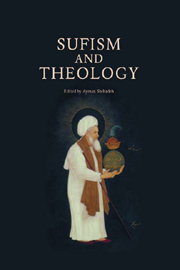Book contents
- Frontmatter
- Contents
- Contributors
- Acknowledgements
- Introduction
- Part I Mystical Theologies
- Part II Theological Approaches to Sufism
- 6 The Mystic and the Sceptic in Fakhr al-Dīn al-Rāzī
- 7 Ibn Taymiyya's Commentary on the Creed of al-Ḥallāj
- 8 Ibn Kemāl (d. 940/1534) on Ibn 'Arabī's Hagiology
- 9 Scriptural Sufism and Scriptural Anti-Sufism: Theology and Mysticism amongst the Shī'ī Akhbāriyya
- 10 Reconciling Sufism with Theology: Abū l-Wafā al-Taftāzānī and the Construct of ‘al-Taṣawwuf al-Islāmī’ in Modern Egypt
- Index
9 - Scriptural Sufism and Scriptural Anti-Sufism: Theology and Mysticism amongst the Shī'ī Akhbāriyya
from Part II - Theological Approaches to Sufism
Published online by Cambridge University Press: 12 September 2012
- Frontmatter
- Contents
- Contributors
- Acknowledgements
- Introduction
- Part I Mystical Theologies
- Part II Theological Approaches to Sufism
- 6 The Mystic and the Sceptic in Fakhr al-Dīn al-Rāzī
- 7 Ibn Taymiyya's Commentary on the Creed of al-Ḥallāj
- 8 Ibn Kemāl (d. 940/1534) on Ibn 'Arabī's Hagiology
- 9 Scriptural Sufism and Scriptural Anti-Sufism: Theology and Mysticism amongst the Shī'ī Akhbāriyya
- 10 Reconciling Sufism with Theology: Abū l-Wafā al-Taftāzānī and the Construct of ‘al-Taṣawwuf al-Islāmī’ in Modern Egypt
- Index
Summary
INTRODUCTION
Pre-modern Islamic literature generally, and classical Shī'ī literature in particular, is characterised by well-defined generic boundaries. Works of jurisprudence, law, theology and Qur'ānic exegesis display remarkable stable structural features between the 5th/11th century and the 13th/late 18th century. In most religious works, topics are presented in a relatively predictable sequence and form a portfolio of doctrines and disputes. Deviation from this disciplinary canon of questions is rare. Navigating different works of uṣūl al-fiqh (jurisprudence or legal theory), for example, written during this period (sometimes called classical and/or post-classical) is reasonably unproblematic after mastering a single text of uṣūl al-fiqh. Chapter order is generally stable, and the opinions entertained in each section are, in the main, rarely augmented by novel opinions after the end of the 8th/14th century. This stability is clearly linked to the context in which such works were composed. Most were designed and used as teaching texts for specific curricula in academic institutions, ranging from the informal study circle to the more institutionalised setting of a school or seminary. The predictability aided the students’ learning and memorisation of the text, whilst simultaneously introducing the students to new aspects of a particular discipline. This generic conservatism should not be taken to indicate any lack of scholarly originality in the classical period. Adept scholars could work within the established rules, and made doctrinal developments and innovations within the discipline incrementally. The structural rigidity of the various genres inevitably encouraged a compartmentalisation of scholarly activity.
- Type
- Chapter
- Information
- Sufism and Theology , pp. 158 - 176Publisher: Edinburgh University PressPrint publication year: 2007



